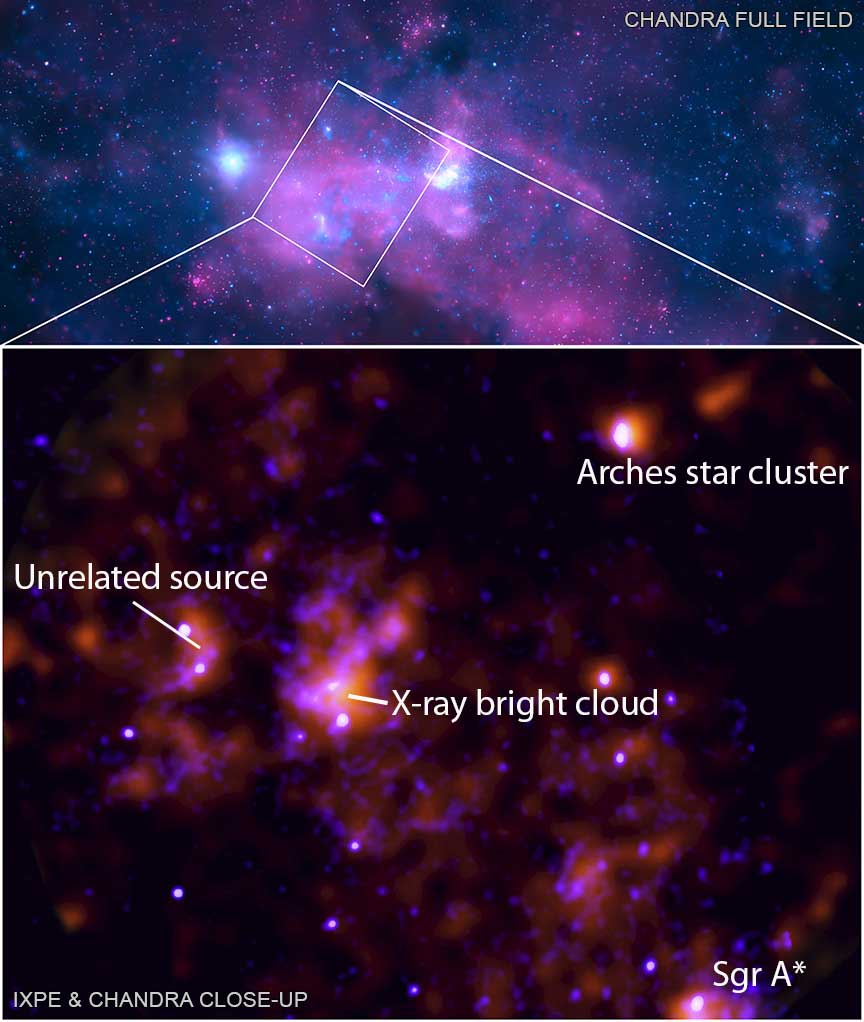A glowing molecular cloud shines today because of a 200-year-old flare let out by our galaxy’s supermassive black hole, scientists say.

IXPE: NASA / MSFC / F. Marin et al; Chandra: NASA / CXC / SAO; Image processing: L.Frattare, J.Major & K.Arcand; Labels added by S&T
The Milky Way's central supermassive black hole, also known as Sagittarius A* (Sgr A* for short), is rather unassuming. Unlike some of the more luminous galactic centers, which are bright beacons visible across the universe, Sgr A* is faint and quiet.
However, it hasn't always been like that. According to new research published in Nature, Sgr A* flared up as recently as two centuries ago. The echo of the outburst, during which the Sgr A* was at least a million times brighter than its present value, is still visible today.
Illuminated Clouds
In the 1990s, astronomers pointed new X-ray telescopes toward our galaxy’s center. They found Sgr A* to be dim, but around it were bright molecular clouds, made of gas and dust that don’t usually emit X-rays.
“One of the hypotheses was that the clouds aren't shining by themselves, but are just reflecting the light from another source, which is much, much brighter,” says Frédéric Marin (Université de Strasbourg, France), who led the new study.
According to predictions, reflected light should be polarized; that is, its waves should vibrate in a preferred direction. But for decades, this kind of observation was out of reach for X-ray satellites. Recently, astronomers were finally able to observe the galactic center with the Imaging X-ray Polarimetry Explorer (IXPE), a satellite specialized for observing the polarization of X-ray light.
“We found that the galactic center . . . isn't polarized, but the clouds themselves are,” Marin says. “So they are indeed scattering light from something else.”
Bright Flare
Ever since the discovery of the shining molecular clouds, Sgr A* has been the prime suspect as the source of light. The new study claims that the observed polarization, in which the signal depends on the direction of the illuminating light, indeed points to Sgr A*.
However, Maïca Clavel (Université Grenoble Alpes, France), who wasn't involved in the study, says that the current quality of the polarization data hardly allows us to make such a claim. Nevertheless, she's confident that Sgr A* is indeed the source astronomers have been looking for. “Based on all the observations that have been gathered since the 1990s, it’s the only candidate that is left,” says Clavel.
Supermassive black holes don’t shine themselves, but any nearby stars, asteroids, or gaseous clouds ripped apart in the black hole’s extreme gravity do. As the material swirls around the black hole, it heats up and emits light across the electromagnetic spectrum.
Based on the distance between the black hole and the clouds, estimated from the measured polarization, the team finds that Sgr A* flared up about 200 years ago. Previous studies have found that the purported flare lasted less than 1.6 years. How bright it became depends not only on its source but also its duration: A yearlong flare would be much fainter than an hourlong one from the same meal. According to the most conservative estimate, Sgr A* brightened by at least a millionfold compared to its present value. The emitted light was comparable to that observed for Seyfert galaxies, a special class of galaxies with actively feeding black holes in their centers.
The team plans to use IXPE to observe the cloud again, hoping to learn more about the past event, including the nature of the object that got ripped apart. Clavel points out that more signal might also show whether there is a significant variation in the polarization properties across the cloud. Perhaps, she speculates, the team might find that Sgr A* spewed out more than one flare in short succession.
Only about 10% of nearby galaxies have active central black holes. While black holes seem to spend most of their time in a quiescent (non-feeding) state, intense phases of activity profoundly affect the evolution of their host galaxies. The recent flare in the Sgr A* therefore provides unique insight into black hole activity and its effects on its immediate environment.
 3
3









Comments
Don-Horne
June 30, 2023 at 4:36 pm
How can we see a flare in SgrA* 200 ya when we are >25,000 ly from it?
You must be logged in to post a comment.
StanR
June 30, 2023 at 5:56 pm
That light would have traveled 200 years "sideways", then reflected towards us. Total path 200 light years greater than the "straight line" distance.
You must be logged in to post a comment.
Don-Horne
June 30, 2023 at 8:26 pm
Thanks, Stan.
You must be logged in to post a comment.
You must be logged in to post a comment.